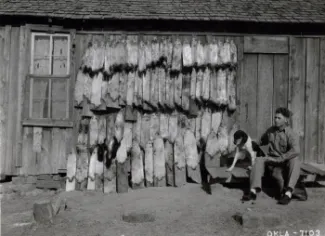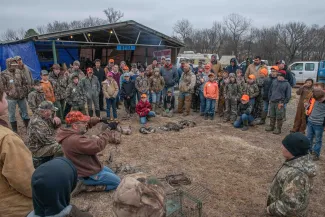Animal skins have been utilized in the lands we now call Oklahoma for thousands of years. Inhabitants used furs for housing, clothing, containers, and as goods in a vast trade network. Burial sites in Oklahoma record copper jewelry from the Great Lakes region, shell beads and conch shells from the Gulf Coast, and turquoise from present-day New Mexico. These examples show the geographical extent of trade within North America until European exploration in the mid-16th century when Spanish conquistadors crossed the Oklahoma Panhandle.
Spain had little interest in anything in the New World other than gold and God. France, however, saw the fortunes to be made from the wildlife that abundantly roamed these lands. The first recorded accounts of trading in Oklahoma were in 1719 by the French, although unlicensed and unaffiliated trapping had been going on for many years. Anchored by the fur trade, French influence in the region grew over the next fifty years. The native tribes bartered and traded buffalo robes, deerskins, beaver pelts and other products for knives, guns, ammunition, cloth and hardware.

Walter Holloway, his dog and 72 skins (69 opossum and 3 skunk) representing all but 39 of his catch of fur between Dec. 1 and Dec. 16th, 1938. Five miles northwest of Stigler, Oklahoma. Photo by M.A. Hurd.
Many entrepreneurs tested their luck, but none were as successful in establishing trading posts and negotiating trade treaties as the Chouteau family. The Chouteau empire was responsible for establishing a major trading post in St. Louis, Missouri which then branched down into the Three Rivers at the convergence of the Neosho, Arkansas, and Verdigris rivers. Towns were named after influential figures in the fur trade like Nathaniel Pryor and Colonel Chouteau. Forts Gibson, Mason and Towson were created in part to protect fur trappers and traders. Iconic people such as Sam Houston and Jesse Chisolm were very involved with the fur trade in Oklahoma.
Following the Louisiana Purchase in 1803, native tribes from the southeastern region of the United States began to migrate westward until the forced relocation of the Five Civilized Tribes began in 1822. This began a shift in the economy and how trade was conducted. Hunting and gathering lessened while agriculture increased. Goods being bartered slowly changed to cash purchases and trading posts began to be replaced by general stores. By 1870 the economic impact of the fur trade was less influential than it had ever been due to modernization and industrialization.
After statehood in 1907, Oklahoma still had a modest fur trade. Bison skins, deerskins, beaver and other furbearing animals were still used for clothing and were shipped across the world. During the Great Depression, some Oklahoma families relied on trapping for additional income as well as food. Fur companies began to lose business as large catalog companies began to advertise for fur in the 1950s. Trapping became less profitable in the 1960s, but the market rebounded a decade later; gray fox pelts that sold for $0.25 in the ‘60s could bring as much as $60 in the ‘70s.
Over the past fifty years in Oklahoma, participation in trapping and the profitability of the fur trade have seen their fair share of peaks and valleys. The Wildlife Department has used regulated trapping to manage some of the state’s natural resources, most notably the reintroductions of white-tailed deer, beaver, and wild turkey populations. Regulations for limits, season, and method of harvest are constantly being monitored and evaluated to ensure the proper management of furbearing species in Oklahoma. Ongoing education and outreach for fur harvesters and wildlife enthusiasts is key to understanding the history, purpose, and role that trapping plays in management.
What once was a cornerstone of trade and subsistence is now a management tool for wildlife professionals, academia, and landowners. The tools of the trade have evolved into regulated, tested, and efficient restraining devices. The market continues to fluctuate on a global scale, but one thing will always remain the same: the need to pair trapping skills with education and dedication to responsible management.

The Oklahoma Fur Bearer Alliance’s trapping camp is dedicated to increasing knowledge of trapping skills.
The Oklahoma Fur Bearers Alliance fosters these skills at their fall convention, held in October, and youth trapper camps, held in December. Get more details about these and other events on the Go Outdoors Oklahoma calendar of events.